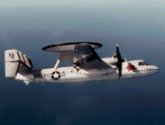
 Designed
and built by Northrop Grumman Corporation, the all-weather E-2C
Airborne Early Warning/Command and Control aircraft has been
in active service with the U.S. Navy since 1973. Egypt, Japan
and Singapore also operate E-2C's, and Taiwan received four Hawkeyes
in 1995. France has ordered two E-2C's for delivery in 1997.
Designed
and built by Northrop Grumman Corporation, the all-weather E-2C
Airborne Early Warning/Command and Control aircraft has been
in active service with the U.S. Navy since 1973. Egypt, Japan
and Singapore also operate E-2C's, and Taiwan received four Hawkeyes
in 1995. France has ordered two E-2C's for delivery in 1997.
With its distinctive 24-foot-diameter rotating radome and more
than 12,000 pounds of sophisticated electronic equipment, the
E-2C Hawkeye can monitor 6 million cubic miles of air space and
more than 150,000 square miles of ocean surface for the presence
of aircraft, missiles, ships, and fixed targets. For example,
an E-2C flying over New York could track all the air traffic
in the congested Boston-to-Washington air corridor.
The Hawkeye's primary mission is defensive. From its operating
altitude, above 30,000 feet, the Hawkeye extends the radar horizon
by overcoming the line-of-sight limitations imposed on ground-based
and shipboard radar systems by the earth's curvature and mountainous
terrain. With its Lockheed Martin AN/APS-145 radar system, the
Hawkeye automatically detects, identifies and tracks targets
at ranges exceeding 300 miles, and its passive detection system
detects and classifies targets at distances beyond radar limits.
The E-2C's capabilities also have proved effective in strike
control, drug interdiction, and search-and-rescue missions.
The long-range, high resolution radar, working with identification-friend-or-foe
(IFF) and passive detection systems through associated computers,
not only develops a picture of the operating environment, but
provides real-time information to air defense centers where command
decisions are made. The E-2C also controls friendly aircraft
for pinpoint interceptions through high-speed data links. The
system can maintain more than 2,000 tracks simultaneously. Track
data includes course, speed, altitude and identification of all
radar, IFF and passive targets in the computer files.
Because the E-2C will serve the Navy well into the next century,
the system continues to be upgraded with significant improvements
to keep pace with the evolving operational environment.
At the end of 1994, Northrop Grumman began work on a mission
computer upgrade program. The new computer will be smaller, lighter
and more powerful. This will allow for even more capabilities,
such as the Cooperative Engagement Center (CEC) upgrade. CEC
will enable the Hawkeye to serve as the fleet's information hub,
fusing information from sources such as satellite and shipborne
radar, and then distributing that information to those who need
it.
Current upgrade programs give the Hawkeye improvements in detection,
processing, identification, communications, and navigation. Modified
aircraft are equipped with the AN/APS-145 radar system with fully
automatic overland targeting and tracking capability, an improved
IFF system, a 40 percent increase in radar and IFF ranges, expanded
processing capacity, new high-target-capacity color displays,
JTIDS for improved secure antijam voice and data communications,
and a Global Positioning System (GPS) for highly accurate navigation.
The flight crew consists of two pilots and three system operators:
a radar operator, air control operator and combat information
center operator. The three system operators work efficiently
and independently in all operational roles: sensor utilization,
monitoring/control of the tactical situation and relay of tactical
information to key battle group participants.
Powered by twin Allison turboprop engines, the Hawkeye combines
fuel economy with short takeoff capability. Current production
aircraft are equipped with T56-A-427 engines, which provide longer
mission duration, greater range and higher altitude capabilities.
In its present configuration, the E-2C can cruise on station
for more than four hours, 200 miles from its base.
The rugged and reliable Hawkeye is the latest of five generations
of electronic warfare aircraft built by Northrop Grumman since
the mid-1940's. At that time, a TBF-3 Avenger was modified with
the first-generation airborne search radar. This was followed
in the mid-1950's by the E-1B. In 1964, the Navy took delivery
of the first aircraft specifically designed for AEW, the E-2A
Hawkeye, 59 of which were delivered through 1967. They flew in
Vietnam combat from the USS Kitty Hawk and USS Ranger. E-2A's
were modified to E-2B's with a new programmable, high-speed digital
computer. The E-2C program began in 1968 and was the third-generation
Hawkeye.
The E-2C prototype made its first flight in 1971, and the first
11 operational aircraft were delivered to the Navy in 1973. By
March 1994, 139 Navy E-2Cs were delivered.
The Hawkeye, an affordable, proven airborne defense system, eliminates
the element of surprise attack, not only from bombers and fighters,
but from low-altitude aircraft, missiles and ships.
Manufacturer: Grumman
Type: Airbourne Early Warning
Length: 56' 4' / 17.07 M
Height: 16' 5" / 5.00 M
Wingspan: 80' 7" / 24.56 M
Wingarea: 700.00 Sq Ft / 65.03 Sq M
Empty Weight: 31154.0 lbs / 14128.0 Kg
Gross Weight: 54829.0 lbs / 24866.0 Kg
Engines: 2 Allison T56-A-425 turboprops (4,910-eph)
Range: 1650 miles / 2657.00 Km
Cruise Speed: 297.00 mph / 478.00 Km/H / 258.38 Kt
Max Speed: 368.00 Mph / 592.00 Km/H / 320.00 Kt
Climb: 2330.00 Ft/min / 710.15 M/min
Ceiling: 30,800 ft / 9390 m
Unit Cost: $51 million
Crew: 5
Armament: None